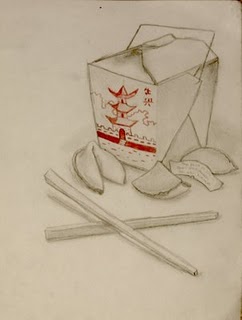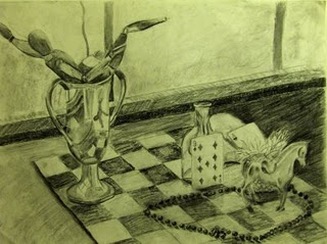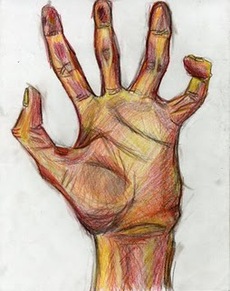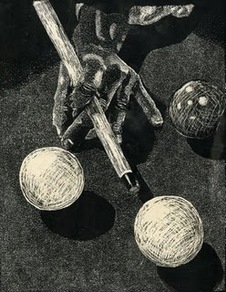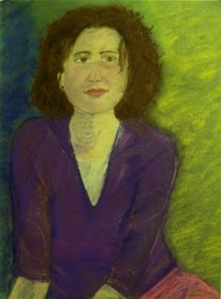Adolescent Art: Artistic Decision
AGE: 14-17 YEARS
During adolescence, students must evaluate the importance of art in their lives and decide whether they wish o further pursue exploring and creating their visual language. Lownefeld terms this stage "artistic decision." Creating art is often an important outlet for young adults. The subject matter of their work often gives inside into the individual's interests and feelings. Those who are stressed or emotionally burdened, often find art production therapeutic. Styles range from realistic to abstract and can deal with complex social issues.
For students who decide to pursue art-making, the quality of their work is less defined by others and becomes a greater result of personal choices. Artists at this stage, however, are fragile. They are quick to notice their own shortcomings and must often be encouraged through honest and constructive criticism. In order to understand how to communicate well through visual means, young students often copy the work of master artists in order to develop specific skills and techniques.
Students who choose not to continue studying art often remain stuck at an earlier stage of development and do not challenge their visual way of seeing and depicting the world. As students gain more mature skills, their work becomes more personal. Adolescents challenge themselves by exploring new media and gaining a variety of skills.
Characteristics to look for:
For students who decide to pursue art-making, the quality of their work is less defined by others and becomes a greater result of personal choices. Artists at this stage, however, are fragile. They are quick to notice their own shortcomings and must often be encouraged through honest and constructive criticism. In order to understand how to communicate well through visual means, young students often copy the work of master artists in order to develop specific skills and techniques.
Students who choose not to continue studying art often remain stuck at an earlier stage of development and do not challenge their visual way of seeing and depicting the world. As students gain more mature skills, their work becomes more personal. Adolescents challenge themselves by exploring new media and gaining a variety of skills.
Characteristics to look for:
|
|
|
Caitlin drew this still-life from observation. Pencil was used to create form and shadows were added to set the objects firmly in space. The overlapping chopsticks gives the objects depth and creates a more interesting space. A red colored pencil was used to emphasize the design on the side of the takeout carton.
This still life drawing was drawn from memory and imagination. Emily looked at references of fruit in order to try and understand the shapes and colors of the fruits. The first component of the drawing was the scratch-board vase. It is decorated by symmetrical stars and stripes. The fruit set-up, composed from imagination, is also symmetrical. Colored pencils were blended to create the illusion of form.
This black and white still live was composed using an assortment of random objects. Different objects were chosen for their formal qualities and drawing challenges. Working from observation, Emily was able to choose a viewpoint that had a strong light source. In the drawing, Emily was challenged to devise ways to describe perspective, contrast, and reflective surfaces.
This sketch, from Emily's sketchbook, uses color as a visual tool. The warm colors were used to create form and also to convey a sense of tension, anger, and movement.
In this scratch-board drawing, Emily depicted the action from an unusual angle. In order to compose the complex perspective, she relied on a photographic reference. At this age, using a photo to develop the image allows the artist to focus on expanding her ability to convincingly convey contrast using a variety of scratch-board techniques. Through these successful drawing experiences, a young artists' confidence increases.
|
Observational drawing becomes a tool for the adolescent artist to use in order to gain confidence in depicting form. The goal of this drawing was to break the face into smaller planes. Using value, Emily is able to create a convincing illusion of 3D form. The black and white plane shifts become easier to read against the neutral beige paper.
This painting is a copy of Frida Kahlo's 1930 Self-Portrait. Copying a master work is a good way to gain an understanding of how to control specific tools and materials. Emily chose this image because of it's color scheme and it's sturdy composition. She learned a lot by painting this image. After sketching the drawing onto a canvas panel, Emily challenged herself to match the painting's original colors by mixing colors multiple times.
This is a page from Emily's sketchbook. As a high school artist, her increased attention span allows her to continue searching for and including descriptive details. This observational portrait was drawn from the front. Her interest in details emerges as she focuses attention on wrinkles, eyelashes, and birthmarks. The striped shirt she chose to wear in this picture adds visual interest to the image.
In this pastel drawing, the model's body is drawn in propotrion. The figure is cropped to draw the focus to her face. In this drawing, the arms and legs are not needed to convey the identity of the sitter. The pastels are blended to create unique hues.
This self-portrait was made at a summer arts enrichment program. Emily was very interested in making art in high school and her art teacher encouraged her to apply to the one-month program. This mixed-media assignment was to create a self-portrait using eight different materials. The objective of the drawing was to experiment with different media. In this one drawing, Emily used colored pencil, charcoal, watercolor, pastels, crayons, paint, craypas, and magazine pictures to create the drawing. She tried to keep the color scheme relatively consistent.
|
